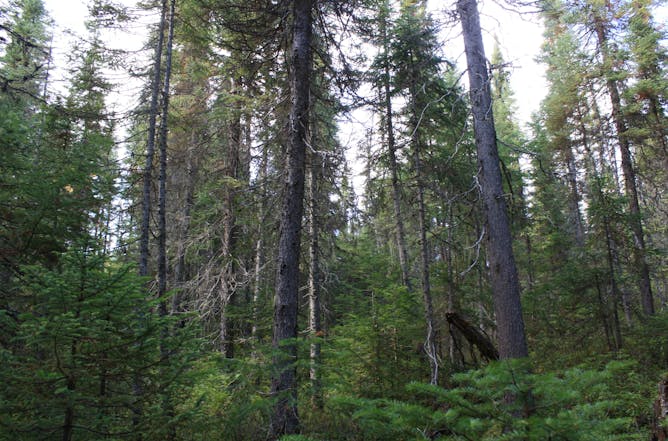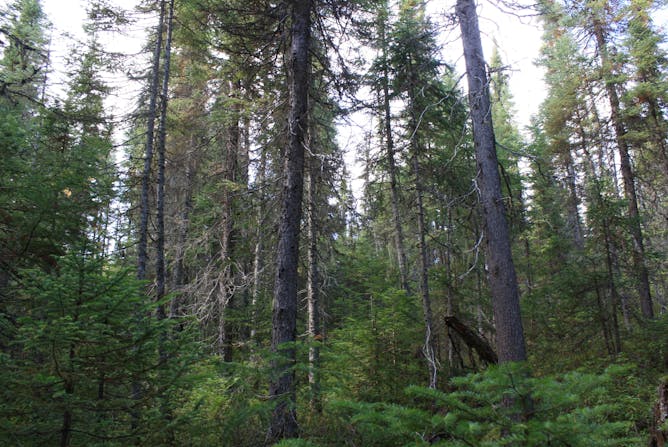|
|
|
|
Canada ranks third in the world for the loss of its intact forests — that is, forests where harvesting activities have never taken place.
Prior to the Industrial Revolution, intact boreal forests were dominated by forests that had not burned for centuries. They are called “old-growth forests.” But just because they’re old doesn’t mean they’re dying or in decline. On the contrary, they are very dynamic and resilient.
In the latest article in La Conversation Canada’s boreal forest series, Maxence Martin and Nicole Fenton, researchers in forest ecology at Université du Québec en Abitibi-Témiscamingue (UQAT), explain why we must leave old forests alone and recommend harvesting young forests instead. “Cutting in intact forests leads to a degradation of the landscape through the loss of old-growth forests. Old forests offer very different habitats and ecological services than young, managed forests.”
Many forest animals, for example, choose to live in dead wood, which is very abundant in old forests. The conservation of old forests and the production of wood are not incompatible objectives — awareness is therefore necessary.
Also today:
All the best,
|

|
Mélissa Khadra
Cheffe de section en science, santé et environnement
|
|

Old spruce and fir forest, over 300 years old.
(Maxence Martin)
Maxence Martin, Université du Québec en Abitibi-Témiscamingue (UQAT); Nicole Fenton, Université du Québec en Abitibi-Témiscamingue (UQAT)
The remoteness and small size of old-growth boreal trees should not make us forget their high ecological importance and the many threats they face.
|

To address the growing urban population, along with the joint affordability and environmental crises, Canada needs to build more affordable, energy-efficient buildings.
(Shutterstock)
Marianne Touchie, University of Toronto
In order to ensure new multi-unit housing prioritizes comfort and health, future residents and building owners should know what design choices to advocate for.
|

In a neoliberal era, where profitability is prioritized over social duty, all orders of government in Canada are increasingly shirking responsibility for providing social services onto non-profits.
(Shutterstock)
Kevin Gosine, Brock University; Darlene Ciuffetelli Parker, Brock University; Tiffany L. Gallagher, Brock University
Non-profits provide critical services and social support for communities. They also provide settings where vital forms of social capital are produced.
|

Social media posts featuring unhealthy foods get more likes and engagement. But there are ways to change that.
(Borzoo Moazami, Unsplash)
Ethan Pancer, Saint Mary’s University; Matthew Philp, Toronto Metropolitan University; Theo Noseworthy, York University, Canada
New research finds that switching to a more thoughtful mindset can increase engagement with healthier food options on social media.
|

Is this really what our Paleolithic ancestors ate? New data suggests prehistoric diets had a lot more overlap with our own than earlier studies estimated.
(Shutterstock)
Mark Collard, Simon Fraser University; Amalea Ruffett, Simon Fraser University
The Paleo Diet is popular, but research has yet to substantiate its purported health benefits. As evolutionary anthropologists, here’s why we think it’s time to leave the Paleo Diet in the past.
|
La Conversation Canada
|

Vieille forêt d'épinettes et de sapins, âgée de plus de 300 ans.
(Maxence Martin)
Maxence Martin, Université du Québec en Abitibi-Témiscamingue (UQAT); Nicole Fenton, Université du Québec en Abitibi-Témiscamingue (UQAT)
L’éloignement et les dimensions modestes des arbres des vieilles forêts boréales ne doivent pas nous faire oublier leur haute importance écologique, ainsi que les nombreuses menaces pesant sur elles.
|
Culture + Society
|
-
Megan Bryson, University of Tennessee
Buddha’s birthday has not always been a major holiday for Buddhists, but is now celebrated in diverse ways throughout Asia.
|
|
Education
|
-
Carmel OShannessy, Australian National University; Jane Simpson, Australian National University; Otto Sims Jungarrayi, Indigenous Knowledge
The Warlpiri Dictionary has been 60 years in the making – and it’s shortlisted for the 2023 Australian Book Industry Awards, a rarity for a dictionary.
|
|
Science + Tech
|
-
Marcin Glowacki, Curtin University
One of the few examples of a fast radio burst and the slow-moving, star forming gas in its origin galaxy has been linked together – thanks to observations from a CSIRO telescope.
|
|
|
|
| |
| |
| |

|
| |
| |
| |
| |
| |
| |
|
|
|
|
|
|
|